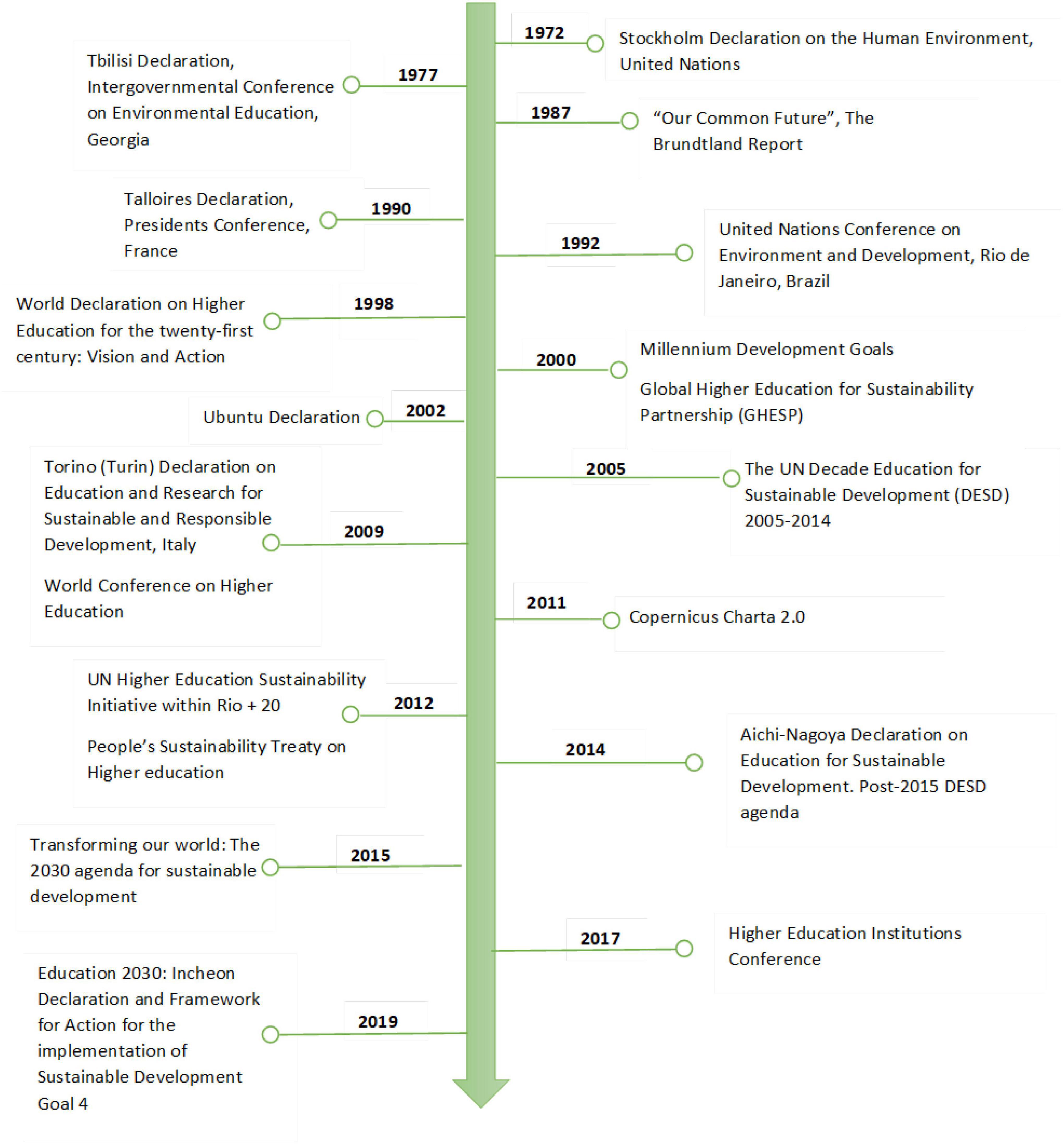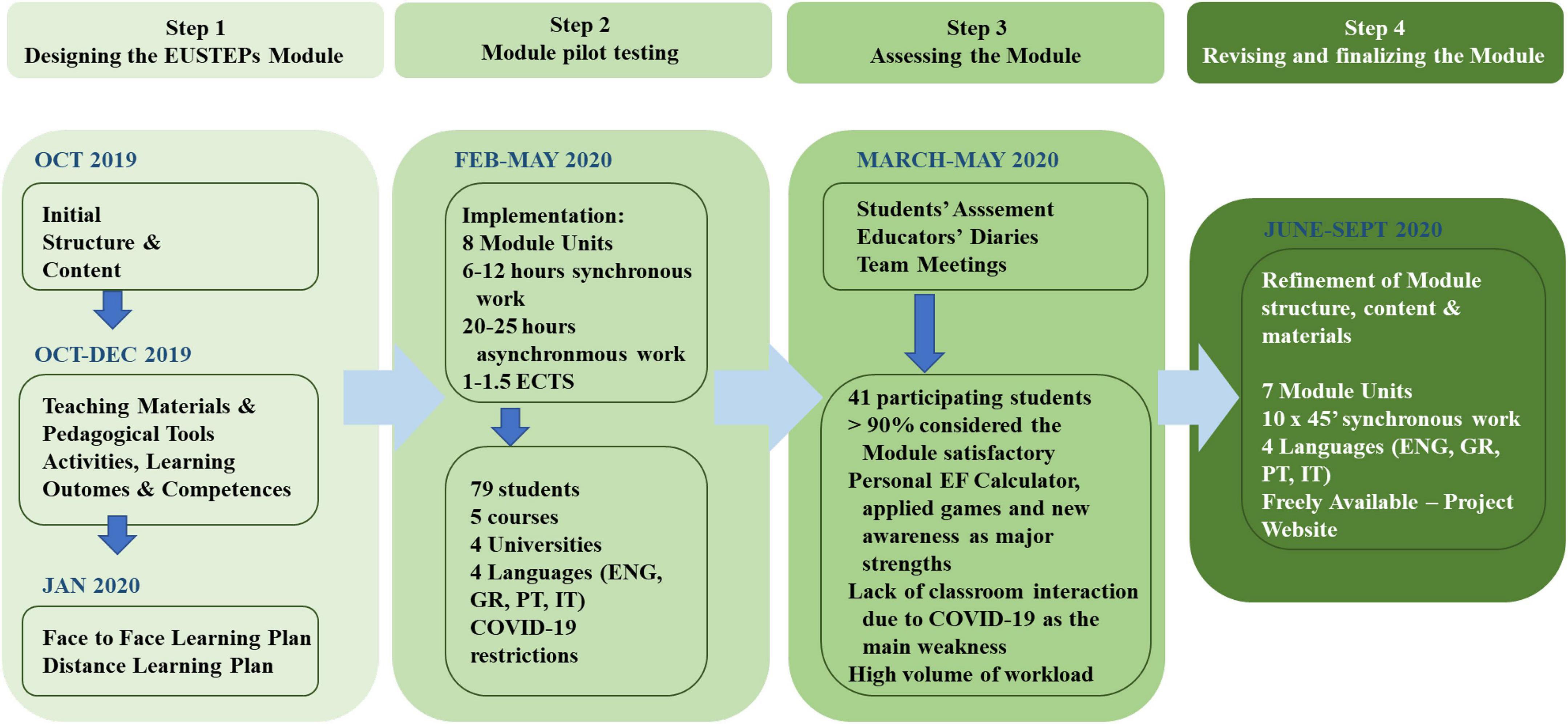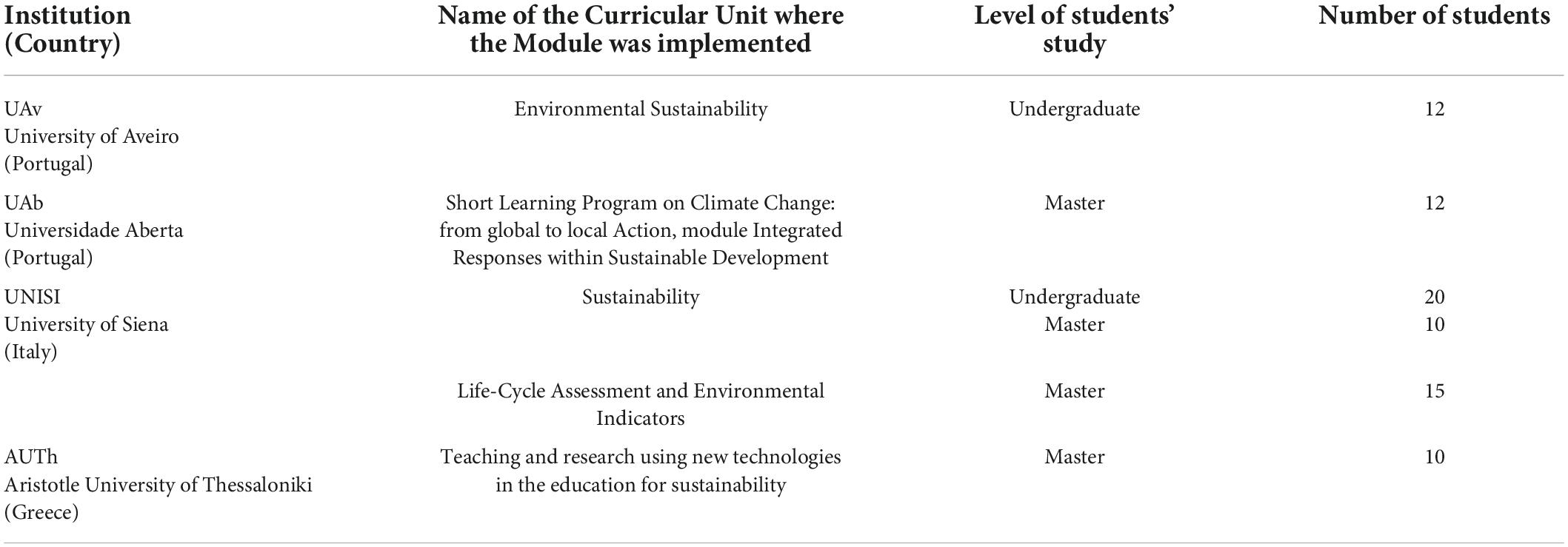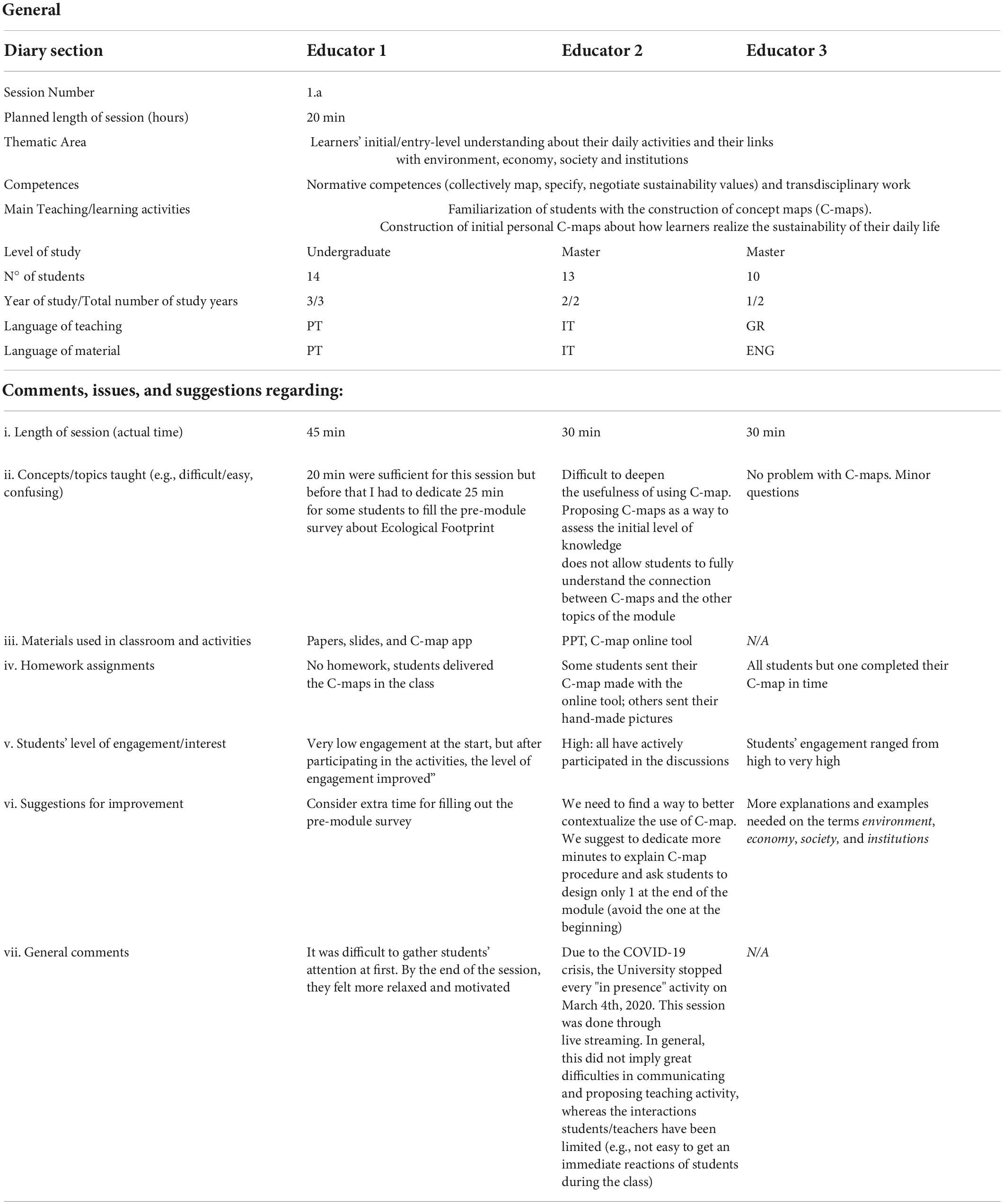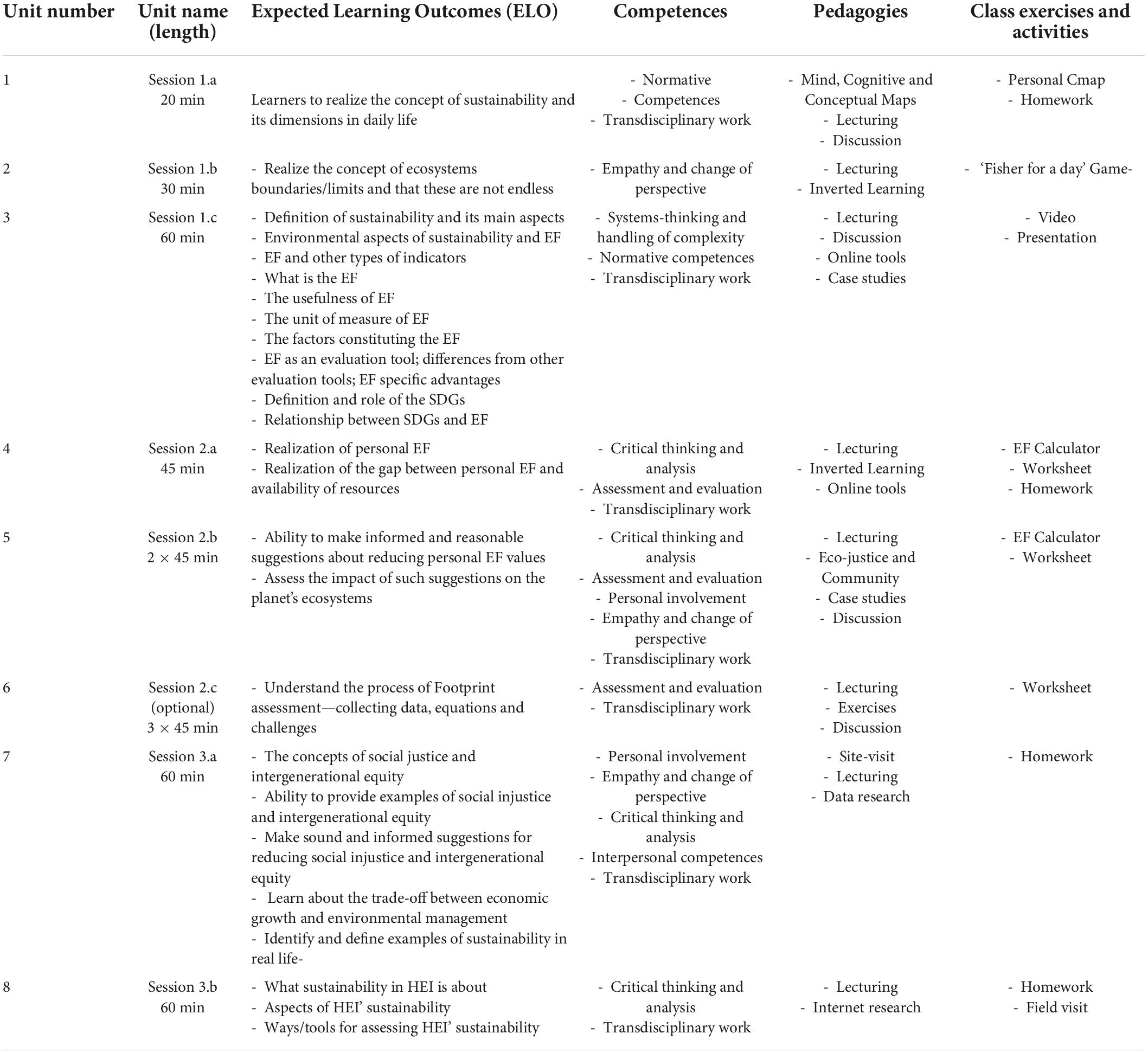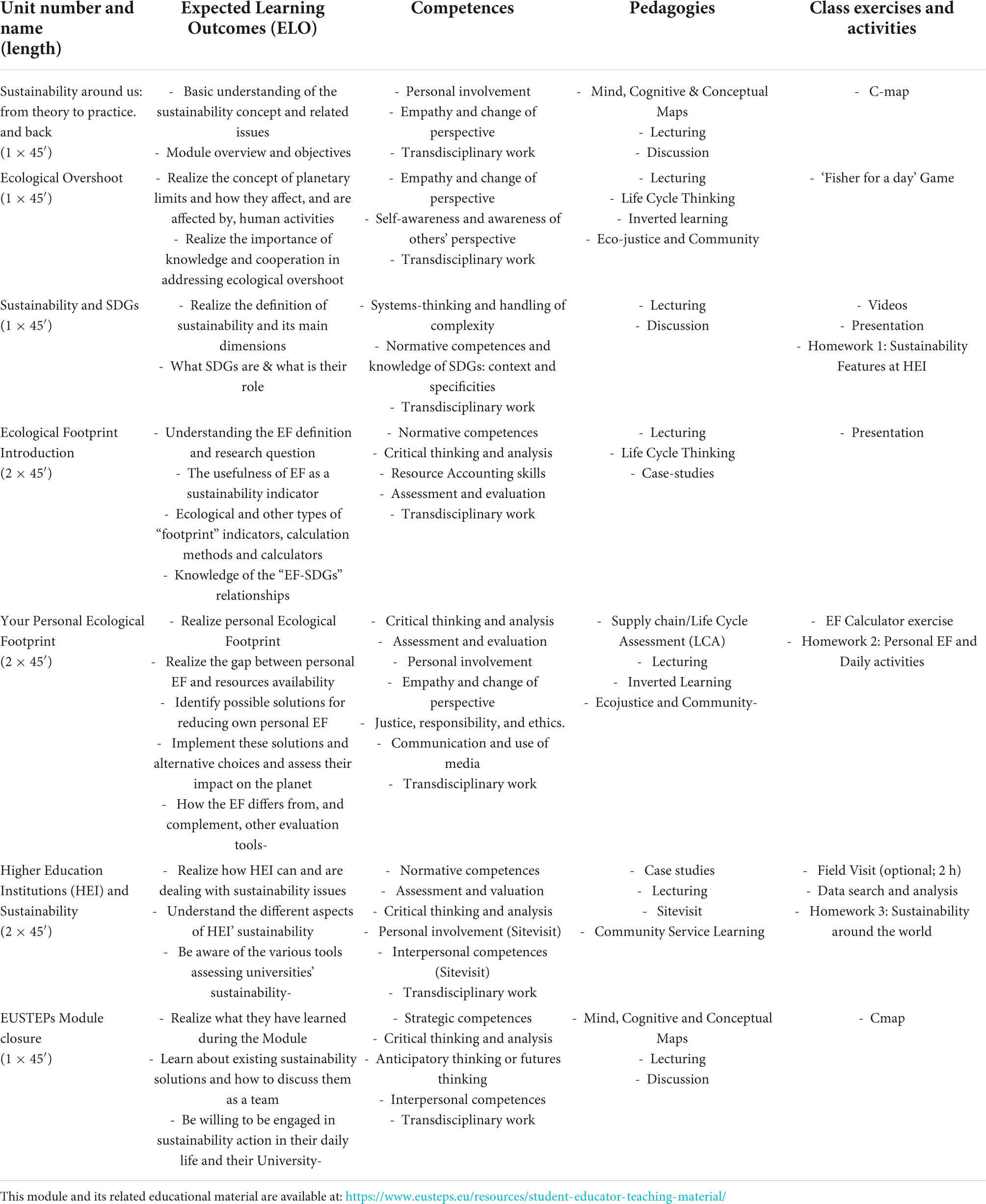Teaching sustainability within the context of everyday life: Steps toward achieving the Sustainable Development Goals through the EUSTEPs Module
- 1Research Unit on Governance, Competitiveness and Public Policies, Department of Social, Political and Territorial Sciences, University of Aveiro, Aveiro, Portugal
- 2Center for Global Studies, Department of Science and Technology, Universidade Aberta, Lisbon, Portugal
- 3Center for Environmental and Sustainability Research (CENSE), School of Science and Technology, NOVA University Lisbon, Lisbon, Portugal
- 4Ecodynamics Group, Department of Physical Sciences, Earth and Environment, University of Siena, Siena, Italy
- 5Department of Primary Education, Aristotle University of Thessaloniki, Thessaloniki, Greece
- 6Centre for Functional Ecology (CFE), University of Coimbra, Coimbra, Portugal
- 7Department of Civil Engineering, Faculty of Engineering, Aristotle University of Thessaloniki, Thessaloniki, Greece
- 8Global Footprint Network, Geneva, Switzerland
In a world characterized by Ecological Overshoot, where humanity demands more from natural ecosystems than they can sustainably renew, education can nurture sustainability-minded citizens and future leaders to help accelerate the transition toward an era where our finite planet’s resources stand at the core of all decision-making. Despite the essential role of Higher Education Institutions (HEI) in contributing to a sustainable society, a holistic understanding of how to incorporate sustainability initiatives into HEI is still lacking. Given the critical role of HEI in societies and considering the number of students, educators, and staff they host every day, ensuring that sustainability is both taught and practiced on campuses becomes fundamental. To this end, a strategic partnership was created in 2019 to set up the ERASMUS + project EUSTEPs—Enhancing Universities’ Sustainability Teaching and Practices through Ecological Footprint. Among the main outputs of the project is a teaching module for introducing the sustainability concept to students. This Module takes a 360-degree approach to teaching sustainability that is designed to help students grasp the extraordinary complexity of sustainability in an engaging and captivating manner. This paperthus aims to: (1) present the EUSTEPs Module, its pedagogical approach and structure, and the learning outcomes and competencies students are expected to gain, (2) review the outcomes of its first pilot teaching in four European HEI, and (3) shed light on how this Module contributes to the development of competences and pedagogical approaches for achieving the Sustainable Development Goals (SDGs). Our findings show that 90% of the students were “satisfied” or “very satisfied” with the Module, rating the Ecological Footprint as the most useful teaching tool among those included in the Module. In addition, they appreciated the interactive nature of the proposed teaching. Feedback obtained from students during the pilot teaching contributed to shaping the Module’s final structure and content. The Module—an important interactive sustainability pedagogical tool—is now ready for use with students in different disciplines, thus contributing to progress toward the UN 2030 Agenda, particularly SDG 4, SDG 11, SDG 12, and SDG 13.
Introduction
In a world characterized by a global human overuse of the Earth’s life-supporting ecosystems services (i.e., Ecological Overshoot) and fast-decreasing natural capital stocks (Lin et al., 2018), education plays a critical role in helping reverse these trends and move toward reaching the goals set by the United Nations 2030 Agenda for Sustainable Development (United Nations [UN], 2015). Education is key to expanding basic sustainability literacy, narrowing social gaps, and favoring a prosperous quality of life, while also contributing to increased awareness of ecosystems’ challenges across all sectors of society (Laurent et al., 2021). Education provides students and wider learner groups with the knowledge, skills and mindsets to address the Sustainable Development Goals (SDGs) through their current or future roles (SDSN, 2020).
HEI are a major driving force behind the shaping of awareness, knowledge, skills, and values in a society. As such, they have a huge responsibility with helping create a sustainable approach to living (Cortese, 2003). Education, as a matter of fact, has been identified as one of the six key transformations needed to achieve the SDGs (Sachs et al., 2019). Modifying the current education systems may represent a pivotal social intervention (Otto et al., 2020), as it can catalyze a social shift toward a new sustainability system-thinking by making awareness of such issues as climate change, resource use/overuse or planetary limits mandatory at all levels of public education.
Recognizing this, four European HEI—Aristotle University of Thessaloniki (AUTh-Greece), University of Aveiro (UAv-Portugal), Universidade Aberta (UAb-Portugal), and University of Siena (UNISI-Italy) —together with the international non-governmental organization (NGO) Global Footprint Network, joined efforts in a project that aims to change the way sustainability is normatively formulated, taught, and implemented within HEI. The 3-year project Enhancing Universities’ Sustainability Teaching and Practices through Ecological Footprint (EUSTEPs), funded by the ERASMUS + program, proposes a “learning-by-doing” approach to raise awareness not only among professors and students all over the European Union but also among HEI administrative and management staff. The EUSTEPs rationale is centered on guiding sustainability system-thinking and educating the wider academic community on the basics of the sustainability concept, Ecological Overshoot and SDGs, through the Ecological Footprint (EF) methodology. The Ecological Footprint is a sustainability metric whose capacity to communicate the scale and significance of humanity’s overuse of the planet’s natural resources in simple and powerful terms has been demonstrated over three decades of implementation around the world (Collins et al., 2020).
Anchored in the leitmotif of “sustainability in everyday life,” the EUSTEPs project has been articulated into two main phases intended to guide students and the wider academic community along their learning journey. The first phase focused on the development of a teaching Module and a Massive Open Online Course (MOOC) customized for the identified target groups: (1) students, (2) teaching staff, and (3) administrative and management staff of HEI. The second phase aimed to involve university communities to co-develop an online, open-access, University Footprint Calculator intended to identify unsustainability drivers and engage the academic community on the necessary process to lower the environmental impacts of universities’ operations.
This paper focuses on the first phase, namely the development of a new sustainability pedagogical Module for undergraduate and post-graduate students. It aims to: (1) present the EUSTEPs Module, its pedagogical approach and structure, and the proposed learning outcomes and competencies students are expected to acquire; (2) review the outcomes of the first pilot teaching in four European HEI, and (3) shed light on how the Module contributes to the development of competences and pedagogical approaches required to reach the global Sustainable Development Goals.
The building-up of education for sustainable development
Since the 1972 United Nations (UN) Stockholm Conference, the education system has been recognized as key in fostering environmental protection and has gained a central role in easing the transition to a sustainable world. Twenty years later the UN Agenda 21 (United Nations Conference on Environment and Development [UNCED], 1992) called for reorienting education toward sustainable development. Consequently, the Decade of Education for Sustainable Development in 2005–2014 (United Nations [UN], 2002) and its follow-up Global Action Programme on Education for Sustainable Development (UNESCO, 2014) were launched by the UN and UNESCO, respectively. However, despite the official acknowledgment of the role of HEI in contributing to sustainable societies (Ramos et al., 2015), tension still exists between different normative views of what “sustainability/sustainable development” is and “what universities should do” (Stough et al., 2018).
From the 1987 Brundtland Report (Harlem, 1987) to the 2012 Rio Earth Summit (United Nations [UN], 2012), several events and declarations (see Figure 1) contributed to building up sustainable development as an established field of research (Wilson and Wu, 2017) and fostering higher education for sustainable development. In the last two decades, a shift has taken place from teaching environmental issues to a broader sustainability agenda (Disterheft et al., 2015); meanwhile, the focus of the literature on environmental sustainability has shifted toward issues of pedagogy, competences, community outreach, and partnerships toward sustainability. As a result of this evolution, the Education for Sustainable Development (ESD) paradigm is currently addressing comprehensive transformative learning and provides equal attention to the environmental, societal, economic, and institutional dimensions.
This ongoing transformation has culminated with the UN 2030 Agenda (United Nations [UN], 2015) —with education included both as a stand-alone goal (SDG 4) and a core element of several other SDGs and targets (including on health, growth and employment, sustainable consumption and production, and climate change). Additionally, the development of the UNESCO Education 2030 Framework for Action, which followed the establishment of SDG 4, contributes to setting several strategic approaches: from strengthening policies, plans, legislation, and national systems, to emphasizing equity, inclusion, and gender equality (UNESCO, 2017, 2020).
Education for Sustainable Development literature has recently started to focus on the connection between how ESD is delivered (pedagogical approaches) and the sustainability competences it might generate (e.g., Lozano et al., 2019). Research by Lozano et al. (2017); Vare et al. (2019), and Moreno Pires et al. (2020), for instance, has highlighted a set of critical competences to handle the complexity of ESD, ranging from more “traditional” competences (e.g., normative and strategic competences, critical thinking and analysis, communication and use of media, or interpersonal competences) to more transformative or disruptive ones (e.g., systems-thinking, anticipatory thinking, empathy and change of perspective, justice, responsibility, and ethics, tolerance for ambiguity and uncertainty or transdisciplinary competences). These competences should be acquired and developed through different pedagogical approaches. The more universal of those approaches rely on case studies that enhance the descriptions of settings, problems, and controversies regarding the definition of sustainable development, together with lecturing that provides access to different materials such as videos or assignments within the classroom context (Moreno Pires et al., 2020). Similarly, encouraging teamwork through interdisciplinary team teaching is beneficial, as well as fostering mind, cognitive and concept maps to deliver a visual impact of sustainability-related concepts. Promoting the development of project-, problem- or challenge-based learning also directs students to non-linear learning, strengthening their engagement in collaborative groups, with the community, or through business partnerships (Lozano et al., 2017).
The potential of the Ecological Footprint as a tool for education for sustainable development
The Ecological Footprint (EF) methodology is not new in the ESD field. Through different approaches and with different groups, it has been used during the last 15 years in multiple teaching efforts across the world (e.g., McNichol et al., 2011; Gottlieb et al., 2012; O’Gorman and Davis, 2013; Global Footpring Network [GFN], 2014; Lambrechts and Van Liedekerke, 2014; Südas and Özeltürkay, 2015; Fernández et al., 2016; Collins et al., 2018), due to its ability to translate personal lifestyle choices into quantitative data. Its use as a pedagogical tool—from kindergarten to universities—has stimulated wide-ranging discussions on how to best influence sustainability education and awareness, connect action-oriented learning with improved students’ knowledge, and ultimately lead to more sustainable behavior patterns (Moreno Pires et al., 2020).
Awareness generation has been recognized as one of the main strengths and value-add of the EF concept and its associated tools (e.g., personal Footprint calculator1) (Collins et al., 2020), as it allows individuals to observe and realize the impact of their personal actions on the planet through a simple message and visually appealing results. Despite acknowledged limitations, teaching and applying EF to every person’s reality inspires debate and generates awareness of personal impact (e.g., Cordero et al., 2008; O’Gorman and Davis, 2013; Collins et al., 2018). Identifying personal Footprint drivers then raises incentives for a shift of attitude and helps quantify the influence each one may have in changing the course of the world (e.g., Ryu and Brody, 2006; McNichol et al., 2011; Collins et al., 2020). Overall, the EF has proven to be an asset when it comes to fostering different sustainability competences such as anticipatory thinking, change of perspective, responsibility, as well as global and personal ethics (Moreno Pires et al., 2020).
Calculating individual EF is not the only way to use the Footprint concept as a pedagogical tool in classrooms. Previous studies have shown, for instance, that calculating the EF of a university encouraged more collective actions and transformations within HEI, guiding campus operations and policy development (Venetoulis, 2001), and engaging students with identifying and implementing transformational activities (Conway et al., 2008; Lambrechts and Van Liedekerke, 2014). Using the EF in HEI’ context could help address more spheres of sustainability ed through this tool, from allowing students to obtain greater knowledge and awareness of their personal impact on sustainability, to stimulating actions and changes in both personal and campus life, for both students and the wider academic community (e.g., teachers, administrative and management staff).
Over time, the EF has proved to be a powerful tool in the classroom (McMillan et al., 2004; Brody and Ryu, 2006; Gottlieb et al., 2012; Collins et al., 2018), but how it is approached by the teacher is also a determining factor for how it is perceived by students. Figure 2 presents different pedagogical approaches and associated sustainability competences which have proven to be relevant when addressing the EF. Developing “empathy and change of perspective” is one of the most common competences when referring to the EF, although targeted audiences are also confronted with justice, responsibility, and ethics when tackled through the perspective of eco-justice and community. Project-based or problem-based learning also present students with real challenges, promoting anticipatory thinking and analysis as well as interpersonal relations and collaboration. Developing mind or conceptual maps with the support of the EF method has also proven to be a powerful learning exercise.
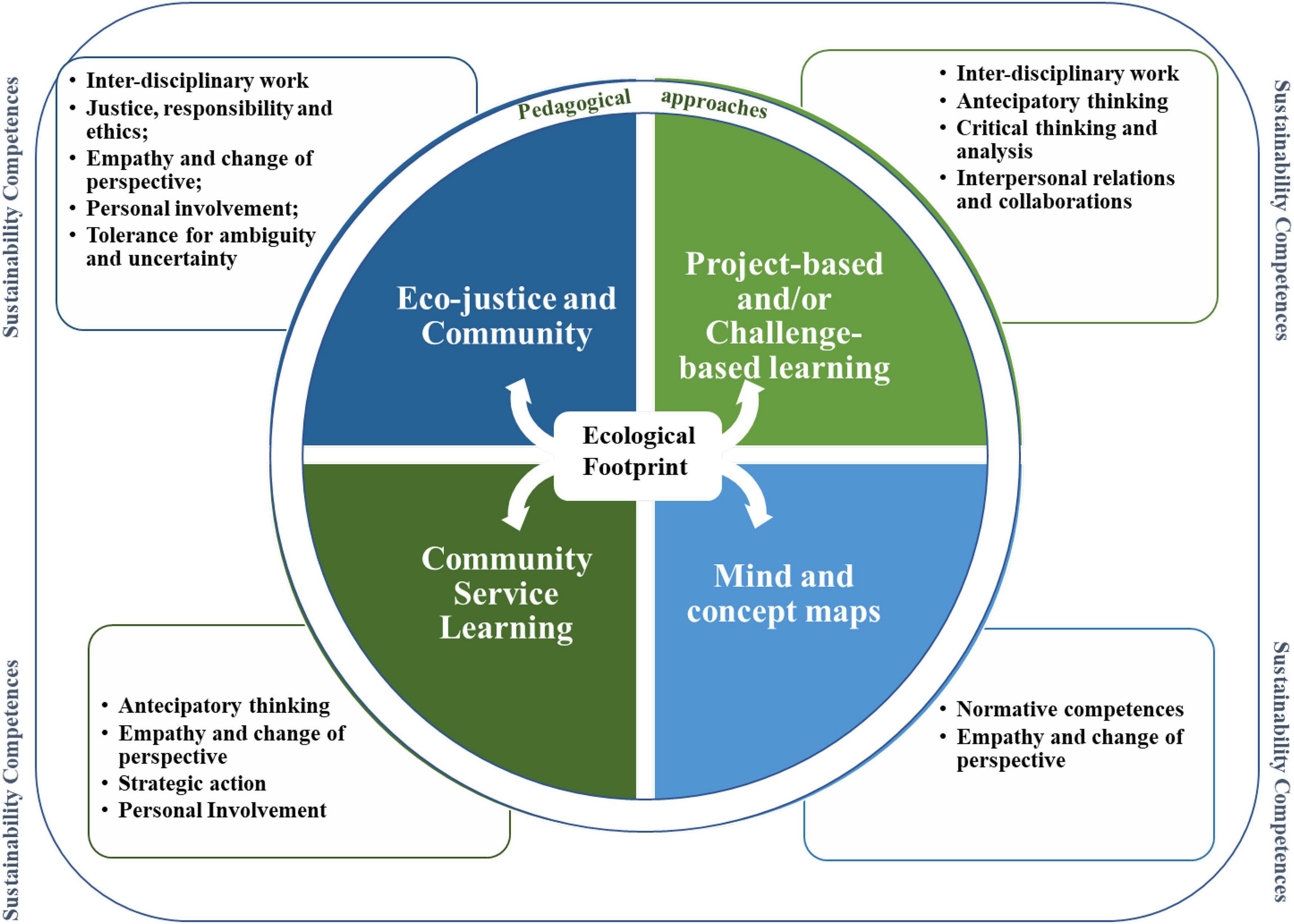
Figure 2. The Ecological Footprint lends itself to various pedagogical approaches and sets of sustainability competences (adapted from Lozano et al., 2019).
Methods
The development of an innovative teaching approach stands as one of the main goals of the EUSTEPs project. As the project intends to pursue learning tools that can be taught in different courses and to different target groups—thus fostering horizontal integration of sustainability in education—a Module was developed to teach sustainability to one of the intended target groups: university students. To do so, a four-step process was adopted: (1) design, (2) test, (3) assessment, and (4) revision of the Module (see Figure 3).
Step 1: Designing the EUSTEPs Module via an interdisciplinary, collaborative approach
A collaborative and interdisciplinary approach was adopted by the EUSTEPs project team: eight Professors and two Post-Doctoral researchers from the four partner universities were involved in developing the Module together with two researchers from Global Footprint Network. This team consisted of individuals from different backgrounds and expertise in different scientific fields: education and pedagogy; environmental sciences; economics; public administration; and public policy. In October 2019, the initial structure and content were discussed, while an integrative literature review of pedagogies, competences, barriers, and challenges was conducted (Moreno Pires et al., 2020). The Module was intended for undergraduate and post-graduate students from all course and degree types. From the start, it was designed so as to be integrated within any existing curricular units or programs across all disciplines—not as a stand-alone course.
The team decided to focus on sustainability in the context of everyday life by considering two core aspects: (i) sustainability as a complex, multi- and trans-disciplinary topic spanning across all fields of education and all spheres of life and (ii) highly interactive teaching in which students experience first-hand, individually and collectively, the crosscutting nature of sustainability. Teaching materials and pedagogies (e.g., slides, educational videos, worksheets), activities (i.e., individual and collective class tasks and homework assignments), and desired competences for the Module were defined in December 2019. A plan was then set to implement the Module in two different forms—face-to-face and distance learning—to reflect the needs of different types of university. Aristotle University of Thessaloniki (AUTh), University of Aveiro (UAv), and University of Siena (UNISI) prepared the face-to-face course, while Universidade Aberta (UAb)—a distance-learning university—framed its online version.
The EUSTEPs Module was set to focus on: (i) Ecological overshoot, sustainability concept, and the SDGs, (ii) EF, its implication for and applications to sustainability debates, and (iii) sustainability and HEI. Therefore, it was structured in 8 different Module Units, for a total of 6 to 12 h of face-to-face lessons, followed by 20–25 h of asynchronous work (equivalent to 1–1.5 ECTS workload, depending on the four universities’ rules). It was developed in English—the language common to all team members—prior to being translated into Greek, Portuguese, and Italian for ease-of-use at the partner universities. Some of the proposed pedagogies, such as the C-map or the “Fisher for a day” game for instance, were tested among the team so as to make necessary adjustments.
The structure, pedagogical tools, and the proposed learning outcomes and competencies are discussed in the results section.
Step 2: Module pilot testing
The Module was applied at the four partner universities during the Spring 2020 semester in a pilot phase. Its teaching started on February 18, 2020, at UAv, soon followed by the other three universities from March 2020 onward. Due to the COVID-19 outbreak, UAv was the sole university that implemented the Module in a face-to-face set-up. AUTh and UNISI implemented the Module with synchronous online sessions using videoconferencing systems, after implementing the necessary adaptation required for that type of teaching. UAb implemented the Module through distance learning as planned, using its pedagogical model (Pereira et al., 2008) and e-learning platform. 79 students across the four universities were involved (see Table 1).
Step 3: Module assessment
Assessing the Module’s effectiveness was considered extremely important for its improvement. To this end, feedback was obtained from both students (via surveys) and educators (via semi-structured written teaching diaries).
Students’ feedback on the strengths and weaknesses of the Module and the received teaching was collected through an online survey tool (i.e., Limesurvey). The survey used both open and closed-form questions in six main areas: (i) general socio-demographic information about students (e.g., gender, nationality, year of study, degree), and main features of the course they were attending (e.g., university, course name and level, semester), (ii) assessment of main characteristics of the Module (e.g., sequence of topics, links between them, schedule, etc.), (iii) feedback on the educational materials and resources, (iv) feedback on the applied homework assignments, v) students’ self-perceived knowledge acquisition and the development of their intentions toward sustainability actions, and (vi) overall effectiveness and satisfaction of/with the Module.
A five-point Likert scale was applied for the closed-form questions (Olsson et al., 2020). Since some educational materials and homework assignments were not taught/applicable to all students, such as field visits canceled due to COVID-19 restriction measures, for instance, an additional answer option was added to the questionnaire to indicate whether the educational materials or homework assignments were applied or not. The survey was validated by the team engaged in the project (Habidin et al., 2015) and applied from March 2020 to May 2020.
For the close-ended questions, a descriptive data analysis was performed. For the open-ended questions, a content analysis was applied through repetitive cycles of developing, refining, grouping, and labeling categories, based on the units of meaning of students’ responses (Ghahramani, 2016).
Data was then collected from educators’ feedback diaries that were filled immediately after teaching each Module Unit. These diaries addressed seven thematic areas of the EUSTEPs Module, namely: (i) efficiency of the scheduled time for implementation, (ii) feedback on the topics and concepts taught including difficulties during teaching, (iii) practicality of, and barriers to, implementing class activities (iv) practicality of, and barriers to, implementing homework assignments, (v) educators’ observations about students’ level of engagement, and (vi) suggestions for improving the Module. In total, five diaries were filled—one from each educator that implemented the Module in his/her curricular unit(s)—and their data analyzed (see the diary structure and one example of the educator’s notes in Table 2). Limitations associated with the questionnaire (e.g., validity, reliability, etc.), such as those associated with participants’ and observers’ errors and bias (Saunders et al., 2007), were taken into account in discussing results and drawing conclusions.
Step 4: Revising and improving the Module
Finally, the set of information included in the educator’s feedback diaries, together with those extracted from the students’ feedback questionnaire, were used to amend and improve the Module structure, content, and material during the June–July 2020 period. Results from this Step are further explained in section “Module improvement.”
Results and discussion
The EUSTEPs Module: Pilot testing
The Module was structured in 8 Units, with two Units proposed as optional (see Table 3 for the overall structure). Different pedagogies were used, ranging from traditional ones (e.g., lecturing, videos), to more interactive ones (e.g., C-maps, games). All classroom and homework activities and assignments were performed in groups of students to further support the learning outcome and collaborative competences. The expected learning outcomes were: (1) understanding the complexity of the sustainability sphere, (2) usefulness and application of the EF methodology, (3) role of HEI in promoting sustainability, and (4) how to assess sustainability and EF at HEI.
Regarding competences, the Module considered six critical competences in particular that are relevant for sustainability learning, namely: normative competences; empathy and change of perspective; systems-thinking and handling of complexity; critical thinking and analysis; assessment and evaluation; and personal involvement. These competences aimed to be developed through the numerous activities developed, discussions, field visits, and supportive educational material (e.g., videos, EF Calculator), thus increasing the potential for successful outcomes. Finally, transdisciplinary work, which is considered a fundamental competence toward sustainability, was also cultivated throughout the entire Module.
Units 1 to 3 were designed as an introduction to ecological overshoot, sustainability and EF concepts, to ensure that knowledge of the main concepts is acquired and students can develop critical thinking throughout the rest of the course. Familiarity with these concepts in the context of daily activities can also help students understand the implications of their personal lifestyles for SDGs achievements and the sustainability of their study-place (i.e., campuses). In Unit 2, for instance, students are engaged in the “Fisher for a day” game, which helps them perceive the notion of planetary and ecosystems limits, while employing cooperation concepts, interactively through inverted learning. With this game, students are able to comprehend that the capacity of nature to provide resources and absorb waste is not infinite, and overshoot leads to the degradation of the Earth’s ecosystems.
Units 4 and 5 introduced the concept of EF as a tool to foster sustainability and track progress toward the SDGs. Students have the opportunity to participate in a 2-round class exercise (see Collins et al., 2018 for further details on this exercise), using the online personal Footprint calculator, to identify their individual EF and discuss solutions on how to reduce the impacts of daily activities. This stimulates debate among students, by comparing and discussing results, as a means to create awareness about personal and collective behavior. The Module includes an optional unit (Unit 6) that details the process of Footprint assessment by focusing on Footprint data and equations.
Unit 7 deals specifically with the HEI’s context and takes into consideration social justice and intergeneration equity. Finally, Unit 8 focuses on concrete examples of HEI and sustainability, existing sustainability-assessment tools, and the role of HEI and their community in enhancing sustainability.
A final collective homework assignment is developed to identify sustainability features at the University Campus, link them with SDGs, and suggest improvement solutions.
Module assessment
Among the 79 participating students, 41 filled the online questionnaire (52%). Gender distribution was almost equally balanced, with 44% male and 56% female students. Most respondents (66%) were enrolled in a postgraduate degree, while 34% were enrolled in an undergraduate degree. Students’ perceptions on different content and materials of the Module are reported in Figure 3.
The most useful educational material was found to be the online EF calculator, closely followed by the “Fisher for a day” game (Figure 4A). The field visit reached a low score in comparison with other educational materials, since only UAv managed to conduct it before the COVID-19 outbreak. However, by considering the results of the open-ended questions, UAv students enjoyed the field visit.
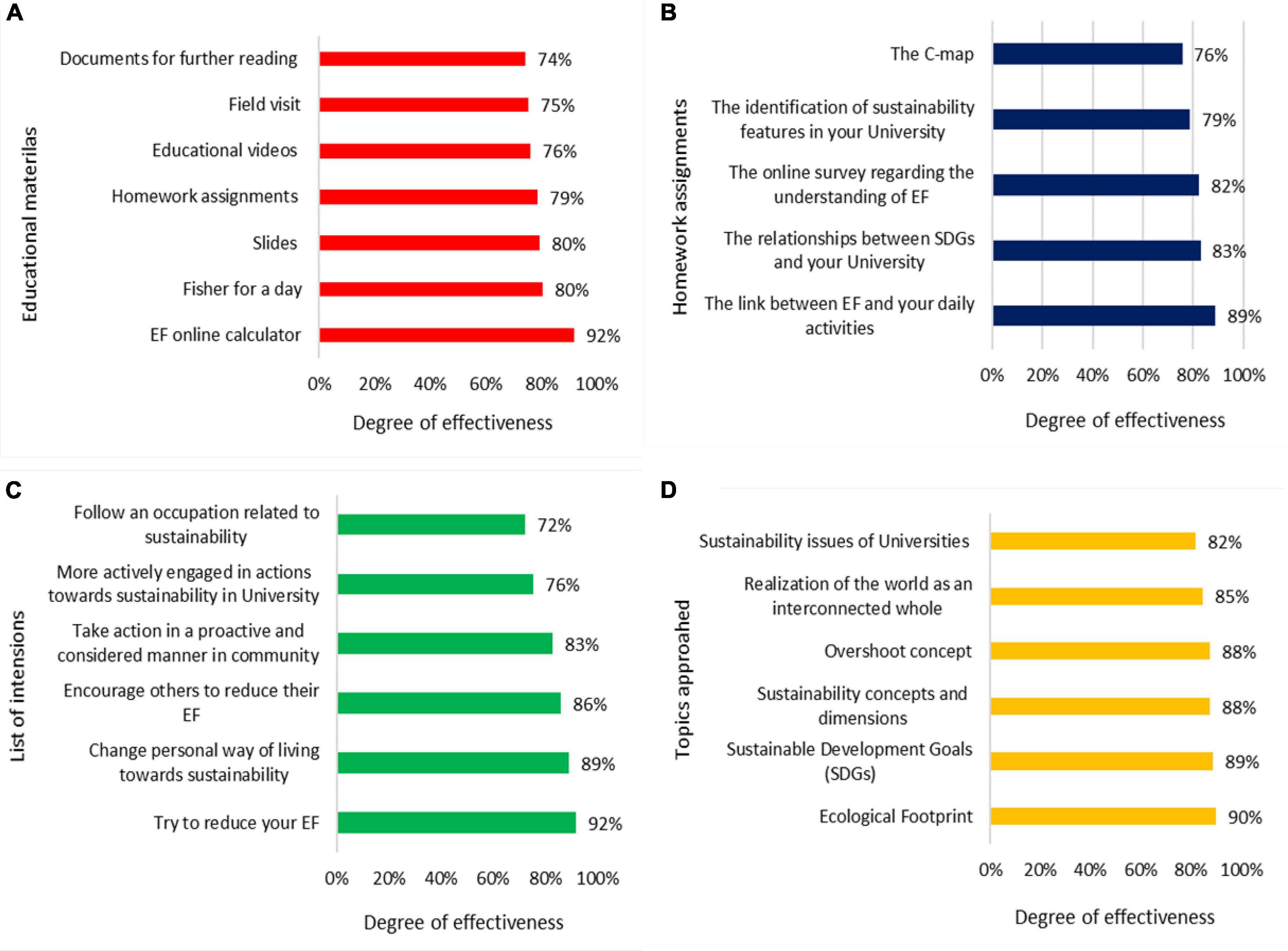
Figure 4. Students’ assessment on (A) usefulness of the educational materials, (B) usefulness of homework assignments, (C) own intention to take future action on sustainability paths, and (D) own understanding of the covered topics.
Most of the students conveyed that the homework assignment entitled “The link between EF and daily activities” (Unit 4) was the most useful homework included in the Module (Figure 4B). Conversely, although C-maps ranked the lowest among homework assignments, they still reached a high level of usefulness (76%). In their answers to the open-ended questions, students deplored that no time was planned for them to discuss their C-map results in the classroom, thus limiting the possibility to learn from such exercise.
After being familiarized with the main concepts, a high rate of students (92%) considered trying to reduce their individual EF (see Figure 4C), closely followed by efforts to change their personal way of living toward sustainability (89%). In addition, 76 and 72% of students considered engaging in sustainability practices within the campus or pursuing a sustainability-related career, respectively. An interesting conclusion is that personal intentions seemed to have increased more than collective and social commitments.
Students attributed high effectiveness to the Module, as they realized it helped them to increase their understanding of all the subjects addressed (Figure 4D). Nonetheless, the Module was considered more useful for the comprehension of the EF topic (90%), closely followed by the SDGs (89%). These results prove how impactful this Module was since the key messages were successfully delivered (all above 80%).
Regarding students’ overall satisfaction, more than 90% deemed the Module satisfactory (Figure 5A) and were very pleased with the lessons and the Module’s characteristics, as well as with its educational materials and resources (Figure 5B).
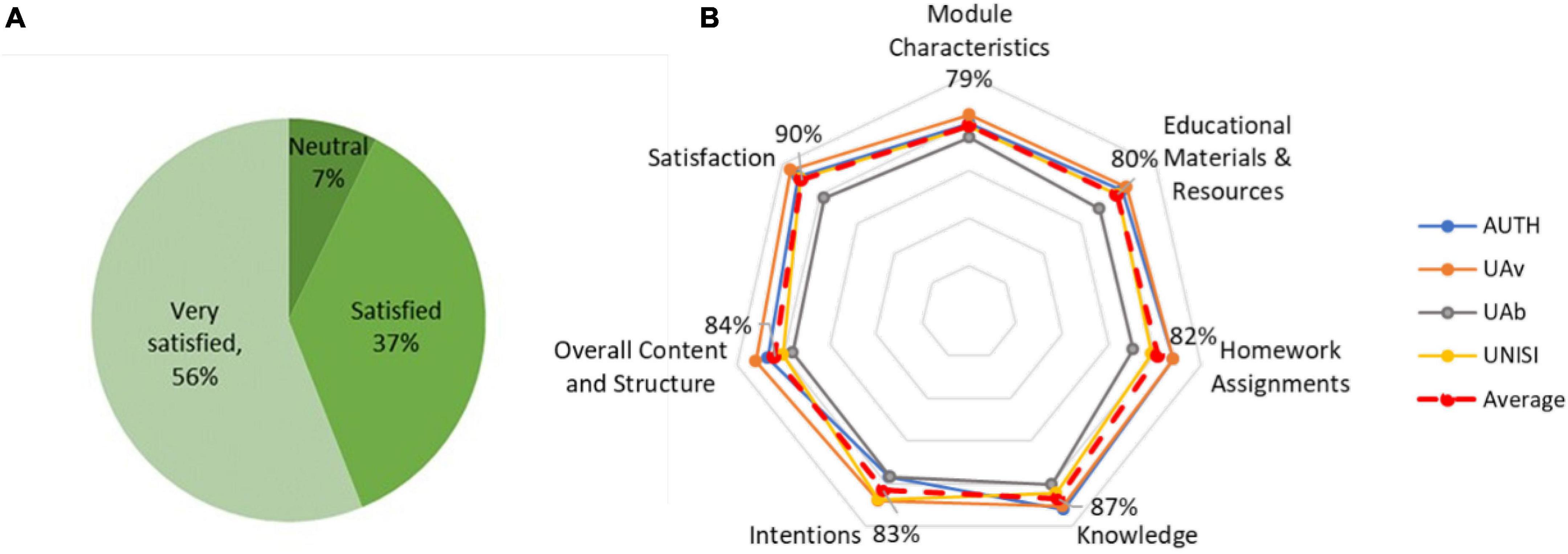
Figure 5. Overall students’ satisfaction (A) and feedback (B) on the EUSTEPs Module. Students’ feedback is broken down by Module features and by University (expressed in percentage of the scoring scale).
Looking at the feedback categorized by the university (Figure 5B), no major differences were found, although the highest satisfaction rates on educational materials, homework assignments, and knowledge improvement on different topics were reported by UAv students—this is likely because UAv was the sole university that taught the Module face-to-face and implemented the field visit before the COVID-19 outbreak. Even though it was prepared to be taught online in the e-learning platform and pedagogical model of UAb, the Module had to be adapted (within a few weeks) to be taught as online synchronous sessions at AUTh and UNISI, at a time when students were still unfamiliar with the online synchronous teaching mode that became prevalent during COVID-related lockdowns. This may explain students’ comments (in the open-ended questions) on the need for more field visits and interaction with educators in the revised version of the Module. Based on the participants’ perceptions of the different educational materials, a comparative analysis between the pilot universities revealed a considerable difference in the results of the “Fisher for a day” game as implemented at UAb (Figure 6). The lower satisfaction rate for UAb students was explained by the fact that these e-learning students had previous working experience in different knowledge areas, and that the majority of them were already familiar with the concept of ecological resource limitation.
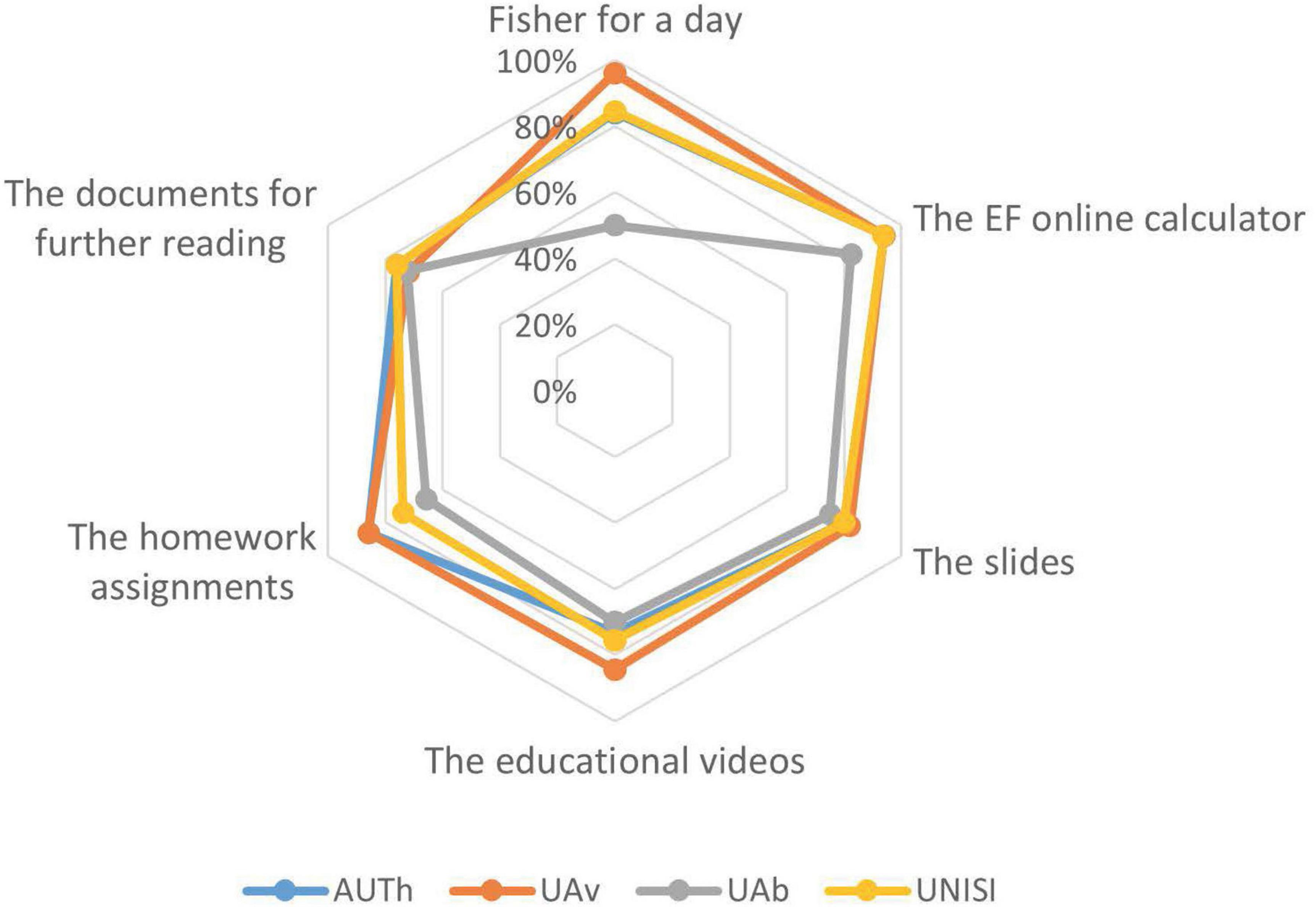
Figure 6. Satisfaction level of the common education materials in the four participating universities.
When asked about the strengths of the Module, the personal Ecological Footprint Calculator and its connection to daily activities received the highest score, somehow supporting previous findings from Collins et al. (2018). Some students also mentioned applied games (i.e., the “Fisher for a day”)—the combination of theory with practice—and new awareness as strengths of the EUSTEPs Module. Conversely, the lack of classroom interaction at AUTh and UNISI due to COVID-19 constraints was highlighted as the main weakness. A few students also mentioned the content’s difficulty level, some even suggesting to lengthening the timeline of the Module to allow further deepening of the topics at hand.
From the educators’ point of view, the Module’s implementation was considered a smooth process. They stressed, nevertheless, the need to incorporate further supporting material and interactive approaches to further engage students. UAv highlighted their students’ growing interest throughout the Module, while other universities’ students’ motivation and engagement were high from the start. A critical aspect was the high volume of workload proposed by the Module which, as indicated by some educators (see Table 2), may lead to a weakening commitment of students and future participating educators throughout the duration of the course. Therefore, one suggestion was to reduce and aggregate some of the work to make the Module more attractive and dynamic. The educators’ endnotes were very positive as they highlighted students’ increased level of engagement throughout the Module, indicating that the Module was off on a very good start. The assessment made by the educators demonstrated the ability of the Module to be taught in different courses and to different target groups.
Students were from different countries and backgrounds, and the Module was taught in different learning regimes. While social sciences students, under the assumption that their knowledge on the topic was not as vast as those who studied environmental sciences, have shown a different posture at the beginning of the Module, and they have displayed a growing level of interest throughout the classes. Students with an environmental background were engaged from the start due to their higher familiarity with sustainability concepts.
Module improvement
Based on both students’ and educators’ feedback discussed above, the structure and content of the Module were modified as shown in Table 4. Both feedback lines were key to the final refinement of the module, whether it is by the perception of the students to the contents, classes and activities, or by the educators’ viewpoint on the feasibility and appropriateness of the content approach in a classroom, virtual or face-to-face, context. Group exercises and homework were reduced to a total of three assignments, in an effort to address the issues of excessive complexity and volume raised in the feedback. This improvement was also aimed at highlighting the consistency between the 3 homework assignments and the three main topics of the Module: (i) Ecological overshoot, sustainability concept and the SDGs, (ii) EF, its implication for and applications to sustainability debates, and (iii) sustainability and HEI. The content of both class activities and homework assignments was enriched by modifying the instructions handouts for educators, to facilitate comprehension and implementation. The length of each Unit was increased, in response to the lack of time identified by both students and educators.
As both educators and students reported limited benefits from C-maps—they were only used as an initial individual activity with no “students-to-students” or “students-to-educators” interaction and no time to draw post-learning maps—the C-map exercise was converted into a collective activity and the second round of C-map exercise was added to the revised closing Unit (7). By conducting the final C-map activity in a collaborative way, the team realized that competences such as interpersonal competences and transdisciplinary work were also better attained.
Since both students and educators suggested adding more explanations and examples regarding some concepts, educational materials (i.e., slides) were revised to (1) include more examples of sustainability best practices, (2) stress the link between EF and SDGs, and (3) deepen the sustainability assessment tools in HEI. In addition, feedback on different educational materials and low results for the “Fisher for a game” at UAb led to the content of Unit 2 being modified. The importance of knowledge and cooperation in addressing the link between ecological overshoot and SDGs was further emphasized in this Unit.
A new homework assignment was also included to address students’ suggestions for more interactive learning. Added to Unit 6 (see Table 4), it requires students to identify successful examples of sustainability practices around the world and to analyze what makes them a long-lasting successful solution. When a field visit is not possible, students will be able to take a virtual “tour” to EF-reduction projects or practices in universities or other organizations, elaborating on the main features and strengths of the selected sustainability projects and discussing how lessons-learning from such best practices can be transferred to other HEI and/or organizations.
The final version of the Module attempts to address the concern expressed by Lozano et al. (2017) regarding the need to equip students with the ability to understand philosophical perspectives on ethics, social justice, and community-building. Following previous studies (e.g., Cordero et al., 2020), pointing to the need to enrich teaching with personal connections on the issues being taught, the EUSTEPs Module was built to contribute to sustainability education through personal qualities and everyday life connections, promoting awareness and personal actions toward sustainability.
Also, based on previous studies (e.g., Conway et al., 2008; Lambrechts and Van Liedekerke, 2014), the EUSTEPS Module encourages students to implement transformational activities by applying the EF tools in the classroom. As such, it proved successful at raising students’ awareness of their personal consumption habits in their daily activities. Through this Module, the students engaged in accounting for their personal EF and thus created more sustainable competences to use natural resources more effectively, subsequently helping to achieve a better education for sustainable development (ESD).
One should bear in mind that the constraints caused by the COVID-19 outbreak raised unforeseen challenges to the implementation of the Module’s original design. Nonetheless, as the results have shown, the educators’ team successfully managed to adapt the content to the new situation.
With a view to strengthening horizontal integration of sustainability within universities, HEI can easily embed the EUSTEPs Module within different existing educational programs, courses, or curricular units since it was designed to be integrated by educators within their existing courses, regardless of the discipline. In fact, a continuous improvement of the Module can only be achieved if more educators engage and implement it. To this end, the Module materials have been made freely available in four languages on the project’s website.2 In addition, since the Module was fully taught and assessed using a proven e-learning platform at the distance-learning university UAb, it has been developed and adapted into a full-fledged MOOC (Massive Open Online Course), which is freely available since June 2022, so that all the academic community and civil society at large can benefit from the EUSTEPs project outcomes.
Conclusion
The world is facing extraordinary environmental challenges today that require unprecedented actions. A new approach to the way mankind looks at, and manages, our planet’s resources is urgently needed. The first step to transitioning to sustainable living and, therefore, to a world where human activities and the planet’s resources are balanced by design, is to educate present and future generations to make positive decisions centered around ecological resources. Higher Education Institutions have a critical role to play in helping society address the Sustainable Development Goals (SDGs).
In this context, the EUSTEPs project proposed a groundbreaking approach to HEI, developing a sustainability teaching Module via a learning-by-doing approach through the use of the Ecological Footprint concept. The EUSTEPs Module was designed by a multi-cultural and trans-disciplinary team to target university students from any field of study or degree. Delivering on SDG4 (and more specifically target 4.7. “Ensure that all learners acquire the knowledge and skills needed to promote sustainable development…”) is the prime objective of the project and of the Module. The results showed that the Module successfully reached its objective since, according to students’ feedback, their understanding of all Sustainability and Ecological Footprint subjects addressed in the Module vividly improved (all above 80%).
Developed in the initial phase of the EUSTEPs’ project, the Module was piloted in the Spring semester of 2020 with 79 students from undergraduate and graduate courses from various scientific backgrounds at 4 different universities. According to students’ feedback, the Module’s first round of implementation provided them with the knowledge, skills, and motivations to understand and address the SDGs through the EF approach. Feedback on the Module was overall positive, as students were receptive and collaborative, and helped enhance the outcomes. The EF was found to be on the top valued feature and the interactive materials were successful. After experiencing the Module, most students indicated their intent to work at reducing their individual EF (92%), closely followed by efforts to change their personal way of living toward sustainability (89%), engage in sustainability practices within the campus (76%), and pursuing a sustainability-related career (72%). Interestingly, personal intentions seemed to be more important than the collective and social commitments, since the two intentions that ranked the highest are more relevant to personal issues: (i) try to reduce your EF and (ii) change your personal way of living.
The overall appreciation of the Module’s design and content demonstrates the importance of embedding interactive pedagogical tools in the classroom as an effective way of knowledge transfer and acquisition.
The EUSTEPs Module stands out for its transformative approach. It has been designed to be easily integrated into the curriculum of any discipline and taught to various student audiences (both graduates and undergraduates). Applying innovative and interactive educational materials and tools (e.g., Ecological Footprint calculator), including both individual (e.g., C-map) and collective (e.g., Fisher for a day), aims to disseminate sustainability knowledge effectively among a diverse group of students and subsequently contribute to the transition to a sustainable society.
Educators, in turn, were pleased with students’ reactions, although with room to improve some aspects. Based on the feedback received, the Module was refined and a revised version is now ready for use by any educator at any university. The plan is to keep facilitating adoption in a variety of courses, reaching more students from different discipline areas. Future research may feature a larger number of learners, hence providing more robust and representative results on the impact this project might have on tomorrow’s leaders.
But HEI are not comprised of students only: educators, administrative staff, and management staff influence the overall performance of HEI’ campuses daily. Achieving sustainability at HEI requires not only educated students who take more proactive action on the sustainability issues but also engaged educators across different disciplines who are properly equipped to teach sustainability modules within their courses in a fun and interactive manner. Consequently, designing sustainability courses to “educate-the-educators” also help in spreading sustainability education.
The EUSTEPs Module’s potential to be transferred to various audiences beyond students is high. Furthermore, applying the Module to teach the wider university community requires no extra resources. It will only require adjusting the existing resources to the specific target specific groups, from educators to administrative staff.
Through its interactive and innovative approach and design, we believe the EUSTEPs Module can directly contribute to SDG 4 in the short-term. Moreover, by educating future citizens and professionals, it can contribute to the long-term achievement of the wider set of goals of the UN Agenda 2030.
Data availability statement
The raw data supporting the conclusions of this article will be made available by the authors, without undue reservation.
Ethics statement
Ethical review and approval were not required for the study on human participants in accordance with the local legislation and institutional requirements. The patients/participants provided their written informed consent to participate in this study.
Author contributions
SMP, GM, and AG conceived the manuscript. MM, MN, and NP elaborated and discussed data and results. AG supervised the manuscript. All authors wrote the manuscript and contributed to the final manuscript.
Funding
The study was supported by the ERASMUS + funded Project “EUSTEPs: Enhancing Universities’ Sustainability Teaching and Practices through Ecological Footprint,” KA 203, Strategic Partnership in Higher Education 2019–2022, Agreement No. 2019-1-EL01-KA203-062941.
Acknowledgments
The EUSTEPs team acknowledge all the students and educators that, during the course of the project, were engaged in the development and pilot testing of the EUSTEPs Module and contributed to its finalization. The team also acknowledges Laetitia Mailhes for her language editing support.
Conflict of interest
The authors declare that the research was conducted in the absence of any commercial or financial relationships that could be construed as a potential conflict of interest.
Publisher’s note
All claims expressed in this article are solely those of the authors and do not necessarily represent those of their affiliated organizations, or those of the publisher, the editors and the reviewers. Any product that may be evaluated in this article, or claim that may be made by its manufacturer, is not guaranteed or endorsed by the publisher.
Supplementary material
The Supplementary Material for this article can be found online at: https://www.frontiersin.org/articles/10.3389/feduc.2022.639793/full#supplementary-material
Footnotes
- ^ https://www.footprintcalculator.org/
- ^ https://www.eusteps.eu/resources/student-educator-teaching-material/
References
Brody, S. D., and Ryu, H. C. (2006). Measuring the educational impacts of a graduate course on sustainable development. Environ. Educ. Res. 12, 179–199. doi: 10.1080/13504620600688955
Collins, A., Galli, A., Hipwood, T., and Murthy, A. (2020). Living within a one planet reality: The contribution of personal footprint calculators. Environ. Res. Lett. 15:2. doi: 10.1088/1748-9326/ab5f96
Collins, A., Galli, A., Patrizi, N., and Pulselli, F. M. (2018). Learning and teaching sustainability: The contribution of ecological footprint calculators. J. Clean. Product. 174, 1000–1010. doi: 10.1016/j.jclepro.2017.11.024
Conway, T. M., Dalton, C., Loo, C. K. J., and Benakoun, L. (2008). Developing ecological footprint scenarios on university campuses: A case study of the University of Toronto at Mississauga. Int. J. Sustain. High. Educ. 9, 4–20. doi: 10.1108/14676370810842157
Cordero, E. C., Centeno, D., and Todd, A. M. (2020). The role of climate change education on individual lifetime carbon emissions. PLoS One 15:e0206266. doi: 10.1371/journal.pone.0206266
Cordero, E. C., Todd, A. M., and Abellera, D. (2008). Climate change education and the ecological footprint. Bull. Am. Meteorol. Soc. 89, 865–872. doi: 10.1175/2007BAMS2432.1
Cortese, A. D. (2003). The critical role of higher education in creating a sustainable future. Plan. High. Educ. 31, 15–22. doi: 10.1891/1078-4535.25.3.e15
Disterheft, A., Caeiro, S., Azeiteiro, U. M., and Leal Filho, W. (2015). Sustainable universities - a study of critical success factors for participatory approaches. J. Clean. Product. 106, 11–21. doi: 10.1016/j.jclepro.2014.01.030
Fernández, M., Alferez, A., Vidal, S., Fernandez, M. Y., and Albareda, S. (2016). Methodological approaches to change consumption habits of future teachers in Barcelona, Spain: reducing their personal Ecological Footprint. J. Clean. Prod. 122, 154–163.
Ghahramani, A. (2016). Factors That Influence the Maintenance and Improvement of OHSAS 18001 in Adopting Companies: A Qualitative Study. J. Clean. Prod. 137, 283–290. doi: 10.1016/j.jclepro.2016.07.087
Global Footpring Network [GFN] (2014). Footprint Futures: A Teaching Module on Human Dependence on the Biosphere. California: Global Footpring Network.
Gottlieb, D., Vigoda-Gadot, E., Haim, A., and Kissinger, M. (2012). The ecological footprint as an educational tool for sustainability: A case study analysis in an Israeli public high school. Int. J. Educ. Dev. 32, 193–200. doi: 10.1016/j.ijedudev.2011.03.007
Habidin, N. F., Zubir, A. F. M., Fuzi, N. M., Latip, N. A. M., and Azman, M. N. A. (2015). Sustainable manufacturing practices in Malaysian automotive industry: Confirmatory factor analysis. J. Glob. Entrepreneursh. Res. 5:4. doi: 10.1186/s40497-015-0033-8
Harlem, B. G. (1987). Our common future (The Brundtland Report). Med. War 4, 17–25. doi: 10.1080/07488008808408783
Lambrechts, W., and Van Liedekerke, L. (2014). Using ecological footprint analysis in higher education: campus operations, policy development and educational purposes. Ecol. Indic. 45, 402–406.
Laurent, É, Battaglia, F., Janoo, A., Galli, A., Dalla Libera Marchiori, G., Munteanu, R., et al. (2021). “Five pathways towards health-environment policy in a wellbeing economy,” in WeALL Policy Paper. Scotland: Wellbeing Economy Alliance.
Lin, D., Hanscom, L., Murthy, A., Galli, A., Evans, M., Neill, E., et al. (2018). Ecological footprint accounting for countries: updates and results of the National Footprint Accounts, 2012–2018. Resource 7:58. doi: 10.3390/resources7030058
Lozano, R., Barreiro-Gen, M., Lozno, F. J., and Sammalisto, K. (2019). Teaching sustainability in European higher education institutions: Assessing the connections between competences and pedagogical approaches. Sustainability 11:1602. doi: 10.3390/su11061602
Lozano, R., Merrill, M. Y., Sammalisto, K., Ceulemans, K., and Lozano, F. J. (2017). Connecting competences and pedagogical approaches for sustainable development in higher education: A literature review and framework proposal. Sustainability 9:1889. doi: 10.3390/su9101889
McMillan, E. E., Wright, T., and Beazley, K. (2004). Impact of a University-Level Environmental Studies Class on Students’ Values. J. Environ. Educ. 35, 19–27. doi: 10.3200/JOEE.35.3.19-27
McNichol, H., Davis, J. M., and O’Brien, K. R. (2011). An ecological footprint for an early learning centre: Identifying opportunities for early childhood sustainability education through interdisciplinary research. Environ. Educ. Res. 17, 689–704. doi: 10.1080/13504622.2011.572161
Moreno Pires, S., Nicolau, M., Mapar, M., Ferreira Dias, M., Horta, D., Bacelar Nicolau, P., et al. (2020). How to Integrate Sustainability Teaching and Learning in Higher Education Institutions? From Context to Action for transformation towards SDGs implementation: A Literature Review. (Aveiro: Universidade de Aveiro) doi: 10.34624/6gq8-9480
O’Gorman, L., and Davis, J. (2013). Ecological footprinting: Its potential as a tool for change in preservice teacher education. Environ. Educ. Res. 19, 779–791. doi: 10.1080/13504622.2012.749979
Olsson, D., Gericke, N., Sass, W., and Pauw, J. B. (2020). Self-perceived action competence for sustainability: The theoretical grounding and empirical validation of a novel research instrument. Environ. Educ. Res. 26, 742–760. doi: 10.1080/13504622.2020.1736991
Otto, I. M., Donges, J. F., Cremades, R., Bhowmik, A., Hewitt, R. J., Lucht, W., et al. (2020). Social tipping dynamics for stabilizing Earth’s climate by 2050. PNAS 117, 2354–2365. doi: 10.1073/pnas.1900577117
Pereira, A., Mendes, A. Q., Morgado, L., Amante, L., and Bidarra, J. (2008). Universidade Aberta’s Pedagogical Model for Distance Education: a University for the Future. Lisboa: Universidade Aberta.
Ramos, T. B., Caeiro, S., Hoof, B. V., Lozano, R., Huisingh, D., and Ceulemans, K. (2015). Experiences from the Implementation of Sustainable Development in Higher Education Institutions: Environmental Management for Sustainable Universities. J. Clean. Product. 106, 3–10. doi: 10.1016/j.jclepro.2015.05.110
Ryu, H. C., and Brody, S. D. (2006). Examining the impacts of a graduate course on sustainable development using ecological footprint analysis. Int. J. Sustain. High. Educ. 7, 158–175. doi: 10.1108/14676370610655931
Sachs, J. D., Schmidt-Traub, G., Mazzucato, M., Messner, D., Nakicenovik, N., and Rockström, J. (2019). Six Transformations to achieve the Sustainable Development Goals. Nat. Sustain. 2, 805–814. doi: 10.1038/s41893-019-0352-9
Saunders, M., Lewis, P., and Thornhill, A. (2007). Research Methods for Business Students. Harlow: Pearson Education Limited.
SDSN (2020). Accelerating Education for the SDGs in Universities: A Guide for Universities, Colleges, and Tertiary and Higher Education Institutions. New York, NY: Sustainable Development Solutions Network.
Stough, T., Ceulemans, K., Lambrechts, W., and Cappuyns, V. (2018). Assessing sustainability in higher education curricula: A critical reflection on validity issues. J. Clean. Product. 172, 4456–4466. doi: 10.1016/j.jclepro.2017.02.017
Südas, H. D., and Özeltürkay. (2015). Analyzing the thoughts of ecological footprints of university students: a preliminary research on Turkish students. Proc. Soc. Behav. Sci. 175:176e184.
UNESCO (2014). UNESCO Roadmap for Implementing the Global Action Programme on Education for Sustainable Development. London: UNESCO.
United Nations [UN] (2002). A/RES/57/254 - United Nations Decade Of Education For Sustainable Development - UN Documents: Gathering A Body Of Global Agreements. San Francisco, CA: United Nations.
United Nations [UN] (2012). “The future we want: Outcome document of the united nations conference on sustainable development,” in Proceedings of the Rio+20 United Nations Conference on Sustainable Development, (San Francisco, CA: United Nations), doi: 10.1126/science.202.4366.409
United Nations Conference on Environment and Development [UNCED] (1992). United Nations Conference on Environment & Development Rio de Janeiro. Brazil: UNCED, doi: 10.1007/s11671-008-9208-3
Vare, P., Arro, G., Hamer de, A., Gobbo, G. D., de Vries, G., Farioli, F., et al. (2019). Devising a competence-based training program for educators of sustainable development: Lessons learned. Sustainability 11:1890. doi: 10.3390/su11071890
Venetoulis, J. (2001). Assessing the ecological impact of a university: The ecological footprint for the University of Redlands. Int. J. Sustain. High. Educ. 2, 180–197. doi: 10.1108/14676370110388381
Keywords: Higher Education Institutions (HEIs), sustainability, Ecological Footprint (EF), teaching module, EUSTEPs, sustainable development goals (SDGs)
Citation: Moreno Pires S, Mapar M, Nicolau M, Patrizi N, Malandrakis G, Pulselli FM, Bacelar Nicolau P, Caeiro S, Niccolucci V, Theodossiou NP, Mancini MS and Galli A (2022) Teaching sustainability within the context of everyday life: Steps toward achieving the Sustainable Development Goals through the EUSTEPs Module. Front. Educ. 7:639793. doi: 10.3389/feduc.2022.639793
Received: 09 December 2020; Accepted: 09 August 2022;
Published: 20 September 2022.
Edited by:
Mark Mifsud, University of Malta, MaltaReviewed by:
Giulia Sonetti, New University of Lisbon, PortugalJason DeHart, Appalachian State University, United States
Copyright © 2022 Moreno Pires, Mapar, Nicolau, Patrizi, Malandrakis, Pulselli, Bacelar Nicolau, Caeiro, Niccolucci, Theodossiou, Mancini and Galli. This is an open-access article distributed under the terms of the Creative Commons Attribution License (CC BY). The use, distribution or reproduction in other forums is permitted, provided the original author(s) and the copyright owner(s) are credited and that the original publication in this journal is cited, in accordance with accepted academic practice. No use, distribution or reproduction is permitted which does not comply with these terms.
*Correspondence: Alessandro Galli, alessandro@footprintnetwork.org
 Sara Moreno Pires
Sara Moreno Pires Mahsa Mapar
Mahsa Mapar Mariana Nicolau
Mariana Nicolau Nicoletta Patrizi
Nicoletta Patrizi Georgios Malandrakis
Georgios Malandrakis Federico M. Pulselli
Federico M. Pulselli Paula Bacelar Nicolau2,6
Paula Bacelar Nicolau2,6  Sandra Caeiro
Sandra Caeiro Valentina Niccolucci
Valentina Niccolucci Nicolaos P. Theodossiou
Nicolaos P. Theodossiou Maria Serena Mancini
Maria Serena Mancini Alessandro Galli
Alessandro Galli